Radiation Safety Training
NOTE: All Training and Testing Material is for LSU CAMD Users ONLY!
Please allow two weeks for your badge to be processed.
Training Objectives
This training will provide you with a basic overview of radiation safety at CAMD. By the end, you should have a good understanding of CAMD’s radiation policies, general radiation terminology, risks and controls at the facility, and your responsibility with regards to safety at CAMD. This training (and annual refresher trainings) are required by Louisiana Department of Environmental Quality’s (DEQ) State regulations and/or LSU radiation safety policy for anyone who may frequent a radiation lab.
Introduction
CAMD is a synchrotron radiation research center at Louisiana State University in Baton Rouge. The mission of CAMD is to provide infrastructure for research and education in synchrotron-based science and technology. The heart of the facility is a 1.5 GeV electron storage ring that was built exclusively to provide synchrotron radiation. As radiation is being produced, safety measures are necessary for anyone who enters the experimental hall or tunnel.
General Information
So what is radiation? Radiation is energy traveling through space. It can be more technically defined as:
The emission or transmission of energy in the form of waves through space or through
a material medium including electromagnetic, acoustic, and particle radiation, as
well as all forms of ionizing radiation.
Why should you care? CAMD produces radiation. Regardless of where you are standing in this facility you
are likely receiving a little extra dose. The closer you get to the inner ring or
the linear accelerator tunnel (LINAC) when they are active, the more you are likely
to receive the little extra dose. These doses are usually highest during injection
or a beam dump.
Is it dangerous? Radiation in high quantities is dangerous. Radiation safety and responsible staff
and users at CAMD have helped guarantee that no one has ever received a high dose
at CAMD.
What would you consider more dangerous?
 2 days in New York City (threat from air quality)
2 days in New York City (threat from air quality)
 Riding 1 mile on a motorcycle (threat from a collision)
Riding 1 mile on a motorcycle (threat from a collision)
 Riding 300 miles in a car (threat from a collision)
Riding 300 miles in a car (threat from a collision)
 Eating 40 tablespoons of peanut butter (aflatoxin)
Eating 40 tablespoons of peanut butter (aflatoxin)
 10 charbroiled steaks (aflatoxin)
10 charbroiled steaks (aflatoxin)
 Smoking 1 cigarette (risk from cancer)
Smoking 1 cigarette (risk from cancer)
 Receiving 3 milirem of radiation dose (risk from cancer)
Receiving 3 milirem of radiation dose (risk from cancer)
According to the Nuclear Regulatory Commission, these all have the same increased risk of death (1 in 1 million). There are other ways to compare radiation risk using the following charts:
| Health Risk | Est. Life Expectancy Lost | Risk by Industry Type | Est. Life Expectancy Lost |
|---|---|---|---|
| Smoking 20 cigarettes a day | 6 years | All Industries | 60 days |
| Overweight (15%) | 2 years | Agriculture | 320 days |
| Alcohol (US Ave) | 1 | Construction | 227 days |
| All Accidents | 207 days | Mining and quarrying |
167 days |
| All Natural Hazards | 7 days | Manufacturing |
40 days |
| Occupational dose (300 mrem/yr) | 15 days |
|
|
| Occupational dose (1 rem/yr) | 51 days |
|
Radiation Basics
Radiation is everywhere! Regardless of where you live in the world, you will receive some amount of radiation dose. Background radiation usually refers to radon gas, cosmic radiation,
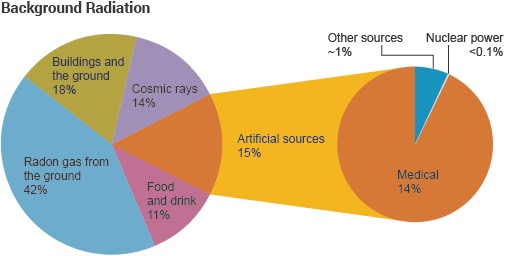
There are several different units used to describe radiation. While CAMD users are not expected to know them all, having a general understanding or recognition of the following terms is helpful. NRC sums these up very nicely:
“There are four different but interrelated units for measuring radioactivity, exposure, absorbed dose, and dose equivalent. These can be remembered by the mnemonic R-E-A-D, as follows, with both common (British, e.g., Ci) and international (metric, e.g., Bq) units in use:
- Radioactivity refers to the amount of ionizing radiation released by a material. Whether it emits alpha or beta particles, gamma rays, x-rays, or neutrons, a quantity of radioactive material is expressed in terms of its radioactivity (or simply its activity), which represents how many atoms in the material decay in a given time period. The units of measure for radioactivity are the curie (Ci) and becquerel (Bq).
- Exposure describes the amount of radiation traveling through the air. Many radiation monitors measure exposure. The units for exposure are the roentgen (R) and coulomb/kilogram (C/kg).
- Absorbed dose describes the amount of radiation absorbed by an object or person (that is, the amount of energy that radioactive sources deposit in materials through which they pass). The units for absorbed dose are the radiation absorbed dose (rad) and gray (Gy).
- Dose equivalent (or effective dose) combines the amount of radiation absorbed and the medical effects of that type of radiation. For beta and gamma radiation, the dose equivalent is the same as the absorbed dose. By contrast, the dose equivalent is larger than the absorbed dose for alpha and neutron radiation, because these types of radiation are more damaging to the human body. Units for dose equivalent are the roentgen equivalent man (rem) and sievert (Sv), and biological dose equivalents are commonly measured in 1/1000th of a rem (known as a millirem or mrem).
For practical purposes, 1 R (exposure) = 1 rad (absorbed dose) = 1 rem or 1000 mrem (dose equivalent)”.
Energy Spectrum
Synchrotron light produced by the 1.5 GeV storage ring ranges greatly in the electromagnetic spectrum. CAMD produces both non-ionizing and ionizing radiation beams. Ionizing radiation is radiation that can cause an atom to lose or gain electrons changing its charge. This allows for a variety of research to be done.
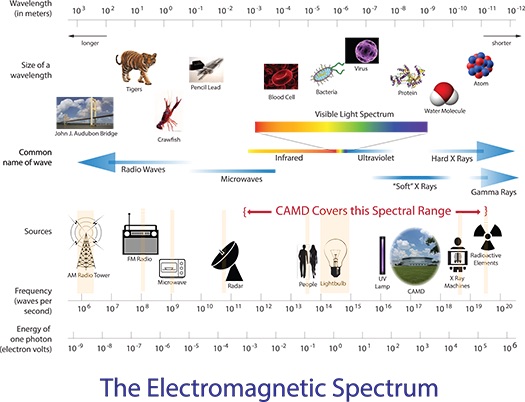
Radiation Biology
Like other toxins and hazards radiation may cause damage when it interacts with our bodies. Living cells can do one of a few things after exposure to radiation(7):
- Repair the cell damage.
- Die and be replaced by another healthy cell.
- Incorrectly repair themselves causing additional damage.
The effects of exposure to radiation can be categorized as Chronic or Acute.
Acute Exposures are a large amount of radiation all at one period of time.
Acute exposures do not typically begin until more than 10,000 mrem as no clinical
effects are observable at these levels. However, beyond this health effects may include:
| Dose equivalent (mrem) | Effect |
|---|---|
| 15,00-25,000 | Blood count changes in some |
| 50,000 | Blood count changes |
| 100,000 | Threshold for vomiting |
| 150,000 | Threshold for death |
| 320,000-360,000 | 50-60% death expectance with minimal care |
| 450,000-540,000 | 50-60% death expectance even with medical care |
| 1,100,000 | 50-60% death expectance even with intensive medical care such as bone marrow transplant |
Other examples of acute effects of radiation include erythema (reddening of skin),
cataracts, hair loss, and sterility.
Chronic exposures are smaller doses over a long period of time. Typically, chronic
exposures refer to cancer incidence. While risk of cancer due to occupational doses
is very small, particularly when compared to background cancer rates, regulations
take a very conservative approach to be cautious. This is called the Linear No-Threshold
Model. Meaning, any amount of radiation may increase your chance of getting cancer.
While this is not supported by research, it is a safe/conservative approach.

The general approach to radiation safety is keeping in mind ALARA. The goal of radiation safety at LSU is to keep radiation doses As Low As Reasonably Achievable (ALARA). The three keys in achieving this are minimizing time near radiation, maximizing distance whenever possible from radiation sources, and utilizing shielding to attenuate (absorb and block) radiation.

Dose Limits and Radiation Areas
| Dose | Area |
|---|---|
| 5 rem | Whole Body Total Effective Dose Equivalent |
| 15 rem | Eye Dose Equivalent |
| 50 rem | Extremity or Organ Dose Equivalent |
| Dose | Area |
|---|---|
| 0.1 rem | Whole Body Total Effective Dose Equivalent |
| Level | Rate | Source Distance |
|---|---|---|
| Radiation Area | An area where 5 mrem/hr | or greater is possible at 30 cm from the source |
| High Radiation Area | An area where 100 mrem/hr | or greater is possible at 30 cm from the source |
| Very High Radiation Area | An area where 500 rad/hr | or greater is possible at 1 meter from the source |
CAMD Details
Now that you have learned about Radiation. Lets cover the details for CAMD.
Access to CAMD
The CAMD facility typically follows university hours. See the operations schedule for more information or to inquire about outside normal hour beam time.
Unescorted access to the experimental hall requires that the person have an active security card and radiation badge. These may be obtained only after radiation safety training and approval of your CAMD contact person. Security cards will be deactivated if you do not renew radiation safety training at annual meetings.
If you are visiting CAMD please have your escort fill out the CAMD guest log at the entrance to the experimental hall.
The security access card is obtained from the facility manager after they have received proof of radiation safety training. A $10 deposit is required and will be returned when access card is returned.
- Security access cards are coded for:
- experimental hall
- after-hours access (requires an additional gate key and director approval)
- cleanroom access (requires additional training and director approval)
Minors and any individuals who are not members of a state supported institution, must
sign an indemnification agreement as part of their radiation training. It is the responsibility
of the person being trained to inform the CAMD safety officer if he/she is not a member
of a state-supported institution. Contact Craig Stevens for this document or more information.
The Experimental Hall
At the center of the hall is the synchrotron ring. This is surrounded by a seven feet high concrete shield. This area may not be accessed during injection or stored beam. The radiation interlock system is in place to make sure no one accidentally accesses these areas when there is a potential radiation hazard.
Outside of the concrete walls are the beamlines. Some of these are surrounded by radiation interlocked hutches. Just like the ring, hutches shall not be accessed when the beamline is in use.
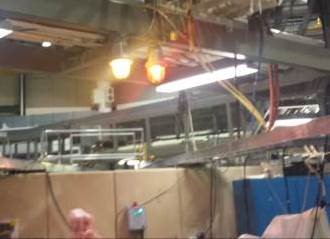
Two lights are used to indicate the arming of the interlock system (red) and that
beam is about to be injected, or stored beam (white).
Injection is preceded by a verbal announcement" Prepare for injection" followed by
the following: "Injection. Injection, Injection". When injection is complete you will
hear "Injection is complete". It is ALARA to maximize your distance from the ring
during injection. During injection and a beam dump are when the facility doses will
be highest.
Radiation and Safety Policies are posted on the website at User Forms and Policies and scrolling down to the policies section. As these should be regularly updated, please check them periodically.
Radiation Badges
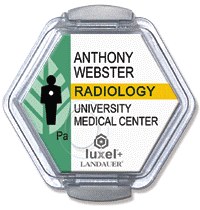
LSU Campus Radiation Safety’s Rule
The LSU radiation safety program will be conducted in such a manner so that exposure
to faculty, staff, students, the public, and the environment will be maintained as
low as reasonably achievable (ALARA) and that no radiation exposure will be received
without societal benefit. This will be accomplished without impeding legitimate research,
or realistic teaching objectives.
Each person who handles radioactive materials or irradiator sources must realize that
the ultimate success of a radiation safety program lies in responsible actions by
individuals in their daily work.
Everyone working at CAMD is provided with a radiation badge. The badge is effective
in recording all exposures from photons. The badges are to be kept in your assigned
drawer at the CAMD facility when you are not wearing it. You must wear your badge whenever you are at the CAMD facility. Visitors staying less than one week do not normally receive a radiation badge. Because
of the possibility for activation, personnel dosimeters (badges) should be worn at
all times when at CAMD, even if you are working while the machine is turned off. While
Neutron doses are possible, they are monitored by area badges only.
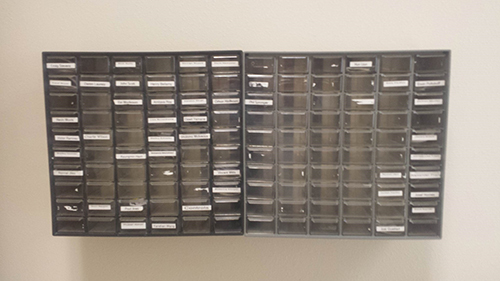

Radiation Monitoring
To best monitor radiation at CAMD, several different measurements are taken. These include:
- Ion chambers with all day live data recording
- Neutron Detectors with all day live data recording
- Environmental badges recording accumulative dose every month
- Environmental badges recording accumulative dose every quarter
- Environmental Neutron badges recording accumulative neutron dose every month
- Weekly surveys of injection and stored beam
Training and survey equipment are available for temporary use with the radiation safety
officer’s approval.
Wear your badge all the time you are at CAMD! Badges must be kept in their assigned drawer when not in use.
Crash Buttons
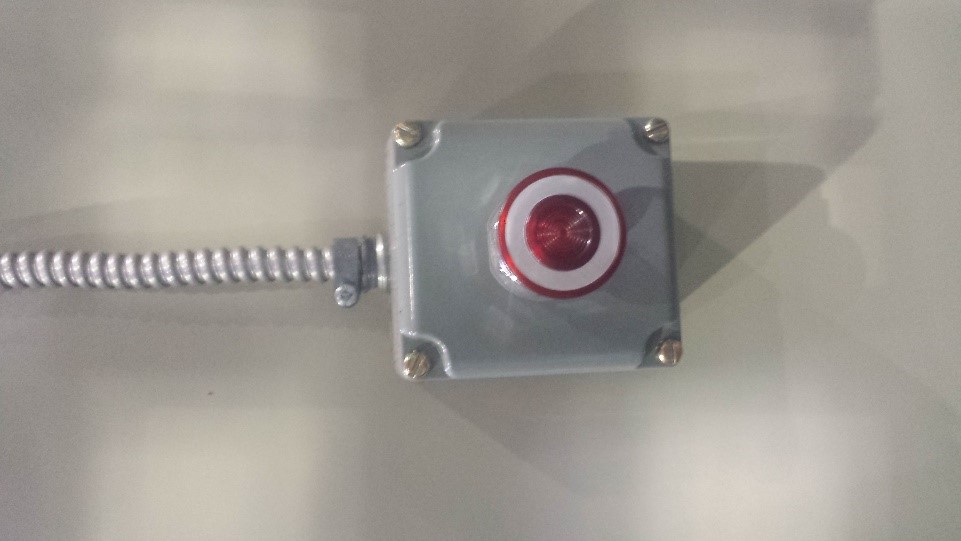
Additional Safety Information
- The stairs to the Linac and Storage ring are very steep, be cautious!
- Fire extinguishers are located around the perimeter of the experimental hall.
- Emergency plans are posted at each beamline, in the cleanroom, and online.
- All CAMD telephones are equipped with a bright orange sticker displaying the emergency telephone numbers.
- There are multiple emergency exits around the experimental hall.
- Fire alarm pull stations are also located at these doors.
- The fire alarm system is tied to a security company and will make the necessary notification.
- For other emergencies you may dial 911 from a CAMD telephone to be directly connected to the LSU police.
- They will address the nature of the emergency and release the appropriate emergency personnel.
Personnel Safety Tips
Do's
- Do read and obey signs
- Wear badges while at CAMD
- Leave badge in drawer when off-site
- Ask if unsure
- Verify you have the correct badge
- Request MSDS for all chemicals and inform CAMD safety of their use.
Don'ts
- Don’t climb above the shield
- Don't move shielding
- Don't move monitoring equipment
- Don't lend or borrow badge
- Don't escort visitors without wearing your badge.
- Don’t work alone
- Don’t bring chemicals without CAMD safety approval
Contact the Radiation Safety Officer with any questions pertaining to this material.
Key Terminology
Activation – Radiation caused by irradiation (creating a radioisotope by bombarding it with other
radiation).
Activity – the number of spontaneous nuclear transformations which occur in a quantity of
a radioactive nuclide per unit time.
Beam – a flow of electromagnetic or particulate radiation directed within a small angle.
Dose – Mean energy imparted into mass. It should be more precisely referred to as Equivalent,
Absorbed, or Effective Dose.
Interlock – A device which automatically shuts off or reduces radiation from an accelerator
to prevent unintentional exposure to radiation.
Exposure – A measure of radiation in air.
Bremsstrahlung – radiation associated with the acceleration or deceleration of charged particles.
Synchrotron Radiation - radiation which occurs when charged particles are accelerated in a curved path
or orbit.
For more information:
- World Nuclear Association - Is Radiation Safe?
- Health Physics Society - Radiation Risk in Perspective (pdf)
- U.S. NRC - Radiation and Its Health Effects
- UNIVERSITY of WISCONSIN–MADISON - Radiation Training Manual
- U.S. NRC - Backgrounder on Biological Effects of Radiation (pdf)
- U.S. NRC - Biological Effects of Radiation (pdf)